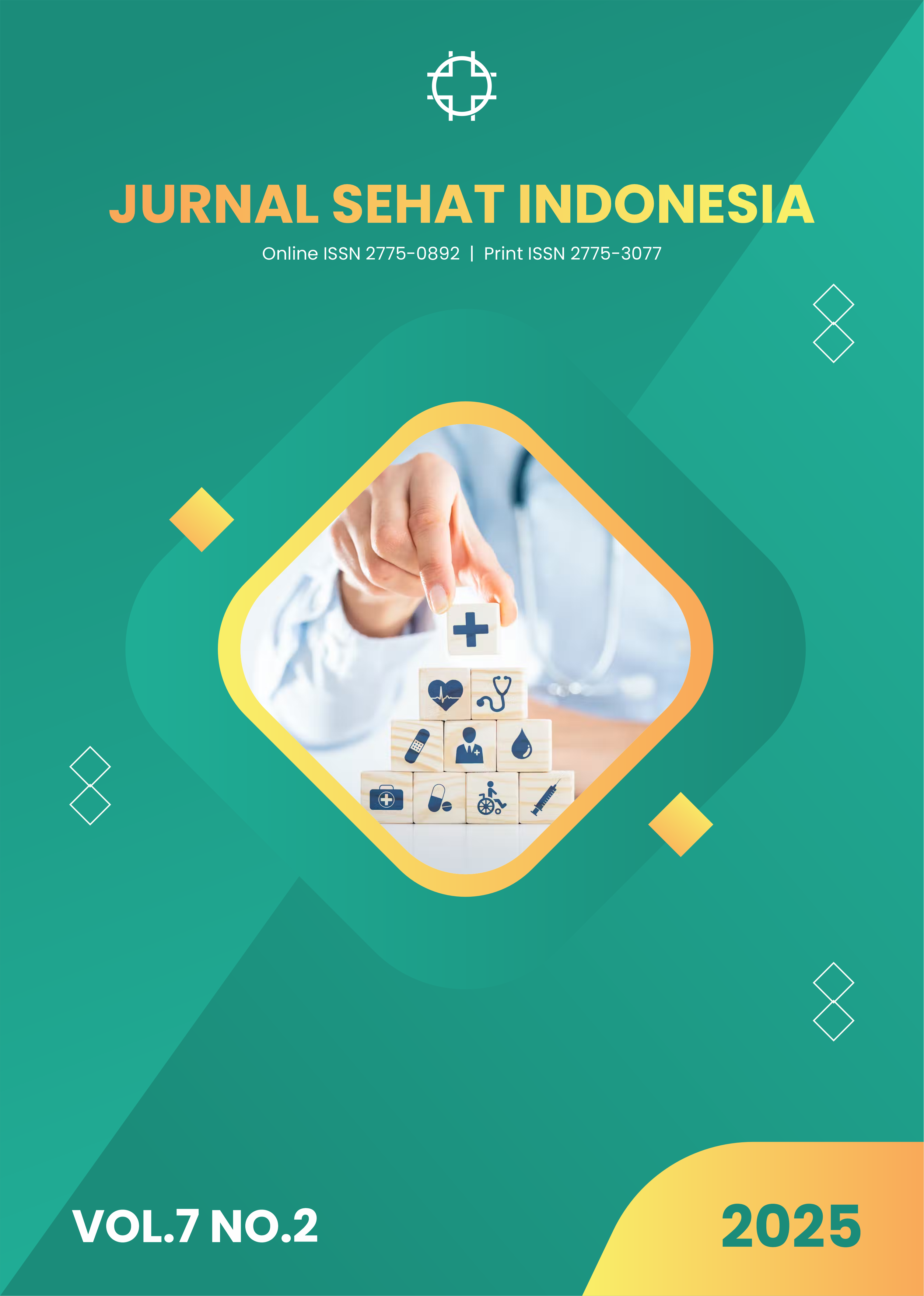Relationship Between Leukocyte Esterase and Nitrite in Urine in Patients with Urinary Tract Infections at Suai Referral Hospital Covalima Timor-Leste
DOI:
https://doi.org/10.59141/.v7i2.394Keywords:
Leukocyte esterase, Nitrite, Urinary Tract Infection (UTI)Abstract
Urinary tract infections (UTIs) represent a significant healthcare concern, particularly among females. Accurate diagnosis is imperative to prevent complications associated with UTIs. The urinalysis procedure, often referred to as dipstick analysis, serves as a preliminary screening test for the identification of UTIs. This analysis typically examines two parameters: leukocyte esterase and nitrite. However, these parameters exhibit varying degrees of sensitivity and specificity in detecting UTIs. This study aims to ascertain the relationship between leukocyte esterase and nitrite in the urine of patients with UTIs. An observational analytical design with a cross-sectional approach was adopted. Samples were randomly selected from a cohort of 50 patients diagnosed with UTIs at Suai Referral Hospital in Covalima, Timor-Leste. Data were analyzed using the chi-square test in SPSS. The results indicated that 80% of UTI patients were leukocyte esterase–positive, while the remaining 20% were negative. Furthermore, 50% were nitrite-positive, and the remaining 50% were negative. Statistical analysis revealed no significant association between the presence of leukocyte esterase and nitrite in the urine of UTI patients (p = 0.480; p > 0.05). Consequently, no statistically significant relationship was identified between leukocyte esterase and nitrite levels in the urine of UTI patients. Therefore, urine dipstick examination should be complemented by more precise methods, such as urine culture, to ensure a more accurate diagnosis.
Downloads
References
Abbas, M., Mus, R., Siahaya, P. G., Tamalsir, D., Astuty, E., & Tanihatu, G. E. (2023). Upaya Preventif Infeksi Saluran Kemih (ISK) melalui Skrining Pemeriksaan Urine pada Remaja Putri. Jurnal Kreativitas Pengabdian Kepada Masyarakat (PKM), 6(10), 4317–4327. https://doi.org/10.33024/jkpm.v6i10.12248
Advani, S. D., North, R., Turner, N. A., Ahmadi, S., Denniss, J., Francis, A., Johnson, R., Hasan, A., Mirza, F., Pardue, S., Rao, M., Rosshandler, Y., Tang, H., Schmader, K. E., & Anderson, D. J. (2024). Performance of Urinalysis Parameters in Predicting Urinary Tract Infection: Does One Size Fit All? Clinical Infectious Diseases, 79(3), 600–603. https://doi.org/10.1093/cid/ciae230
Agpaoa et al. (2015). Predict Urinary Tract Infection and to Estimate Causative Bacterial Class in a Philippine Subspecialty Hospital. Journal of Nephrology & Therapeutics, 05(02). https://doi.org/10.4172/2161-0959.1000194
Demilie, T., Beyene, G., Melaku, S., & Tsegaye, W. (2014). Diagnostic accuracy of rapid urine dipstick test to predict urinary tract infection among pregnant women in Felege Hiwot Referral Hospital, Bahir Dar, North West Ethiopia. BMC Research Notes, 7(1), 1–5. https://doi.org/10.1186/1756-0500-7-481
Dr. Katherine Klos, M. (2024). How to read UTI test strip results | Uqora®. https://uqora.info/blogs/learning-center/how-to-read-uti-test-strips
Ginting, F., Sugianli, A. K., Kusumawati, R. L., Parwati, I., De Jong, M. D., Schultsz, C., & Van Leth, F. (2018). Predictive value of the urinary dipstick test in the management of patients with urinary tract infection-associated symptoms in primary care in Indonesia: A cross-sectional study. BMJ Open, 8(8). https://doi.org/10.1136/bmjopen-2018-023051
Hospital Referal de Suai. (2023). Relatorio Sobre Dez Pricipais Doencas em Hospital Referal de Suai.
Human Bio Media. (2024). Urinalysis Lab Simulation The Chemical Exam. Human Bio Media. https://www.humanbiomedia.org/about-us/
Malau, U. N., & Adipireno, P. (2019). Uji korelasi leukosit esterase dan nitrit dengan kultur urin pada infeksi saluran kemih. Intisari Sains Medis, 10(1), 184–187. https://doi.org/10.15562/ism.v10i1.343
Mambatta, A., Jayarajan, J., Rashme, V., Harini, S., Menon, S., & Kuppusamy, J. (2015). Reliability of dipstick assay in predicting urinary tract infection. Journal of Family Medicine and Primary Care, 4(2), 265. https://doi.org/10.4103/2249-4863.154672
Maulani, D., & Siagian, E. (2021). Hubungan Pengetahuan Dan Kebersihan Urogenital Dengan Infeksi Saluran Kemih. Jurnal Penelitian Perawat Profesional, 3(1), 153–158.
Nancy A. Brunzel. (2023). Fundamentals of Urine and Body Fluid Analysis.
A. (2018). Akurasi Pemeriksaan Uji Dipstik Urin dalam mendiagnosis Infeksi Saluran Kemih (ISK) Nosokomial Simptomatik dan Pola Resistensi ISK Nosokomial di Rumah Sakit Umum Pusat (RSUP) Haji Adam Malik Meda. Repository Universitas Sumatra Utara. http://repositori.usu.ac.id/handle/123456789/8216
Parwati, P. A., & Cahyani, A. A. A. E. (2023). Penilaian Hasil Dipstik Urine (Nitrit Dan Leukosit Esterase) Sebagai Prediktor Bakteriuria. The Journal of Muhammadiyah Medical Laboratory Technologist, 6(1), 108. https://doi.org/10.30651/jmlt.v6i1.18153
Rosero, J. A. B., Alvarez, J. M. G., Soriano, H. J. B., Raymundo, J. R. D., Batisla-on, C. J. E., Morales, K. O., & Lirio, M. R. F. (2021). Prevalence of Escherichia coli in the Community Acquired Bacteremic UTI in Southeast Asian Countries: A Mini-Review. Asian Journal of Biological and Life Sciences, 10(2), 268–273. https://doi.org/10.5530/ajbls.2021.10.38
Sabriani, J., Umboh, A., & Manoppo, J. I. C. (2021). Perbandingan Leukosituria, Nitrit, Leukosit Esterase dengan Kultur Urin dalam Mendiagnosis Infeksi Saluran Kemih pada Anak. Medical Scope Journal, 2(2), 78–86. https://doi.org/10.35790/msj.v2i2.32596
Tuntun, M., & Aminah, S. (2021a). Hubungan Hasil Dipstik Urin (Leukosit Esterase, Nitrit dan Glukosuria) dengan Kejadian ISK pada Pegawai. Jurnal Kesehatan, 12(3), 465. https://doi.org/10.26630/jk.v12i3.2894
Tuntun, M., & Aminah, S. (2021b). Hubungan Hasil Dipstik Urin (Leukosit Esterase, Nitrit dan Glukosuria) dengan Kejadian ISK pada Pegawai The Relationship between Urine Dipstic Results (Leukocyte Esterase, Nitrite, and Glucosuria) with UTI in Employees. Jurnal Kesehatan, 12(3), 465–471. http://ejurnal.poltekkes-tjk.ac.id/index.php/JK
Downloads
Published
How to Cite
Issue
Section
License
Copyright (c) 2025 Juvita Da Costa Gomes, Diah Prihatiningsih, Moh. Fairuz Abadi

This work is licensed under a Creative Commons Attribution-ShareAlike 4.0 International License.
Authors who publish with this journal agree to the following terms:
- Authors retain copyright and grant the journal right of first publication with the work simultaneously licensed under aCreative Commons Attribution-ShareAlike 4.0 International (CC-BY-SA). that allows others to share the work with an acknowledgement of the work's authorship and initial publication in this journal.
- Authors are able to enter into separate, additional contractual arrangements for the non-exclusive distribution of the journal's published version of the work (e.g., post it to an institutional repository or publish it in a book), with an acknowledgement of its initial publication in this journal.
- Authors are permitted and encouraged to post their work online (e.g., in institutional repositories or on their website) prior to and during the submission process, as it can lead to productive exchanges, as well as earlier and greater citation of published work.








